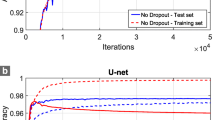Abstract
Corneal endothelial cell segmentation plays a vital role in quantifying clinical indicators such as cell density, coefficient of variation, and hexagonality. However, the corneal endothelium’s uneven reflection and the subject’s tremor and movement cause blurred cell edges in the image, which is difficult to segment, and need more details and context information to release this problem. Due to the limited receptive field of local convolution and continuous downsampling, the existing deep learning segmentation methods cannot make full use of global context and miss many details. This paper proposes a Multi-Branch hybrid Transformer Network (MBT-Net) based on the transformer and body-edge branch. Firstly, we use the convolutional block to focus on local texture feature extraction and establish long-range dependencies over space, channel, and layer by the transformer and residual connection. Besides, we use the body-edge branch to promote local consistency and to provide edge position information. On the self-collected dataset TM-EM3000 and public Alisarine dataset, compared with other State-Of-The-Art (SOTA) methods, the proposed method achieves an improvement.
Access this chapter
Tax calculation will be finalised at checkout
Purchases are for personal use only
Similar content being viewed by others
References
C.H., Qi, X., Yu, L., Heng, P.A.: Dcan: deep contour-aware networks for accurate gland segmentation. In: CVPR, pp. 2487–2496 (2016)
Al-Fahdawi, S., et al.: A fully automated cell segmentation and morphometric parameter system for quantifying corneal endothelial cell morphology. Comput. Methods Programs Biomed. 160, 11–23 (2018)
Chaurasia, A., Culurciello, E.A.: Linknet: exploiting encoder representations for efficient semantic segmentation. In: VCIP, pp. 1–4 (2017)
Chen, J., et al.: Transunet: Transformers make strong encoders for medical image segmentation (2021)
Chen, L.C., Barron, J.T., Papandreou, G., Murphy, K., Yuille, A.L.: Semantic image segmentation with task-specific edge detection using CNNs and a discriminatively trained domain transform. In: Computer Vision and Pattern Recognition (2016)
Ding, H., Jiang, X., Liu, Q.A., Magnenat-Thalmann, N., Wang, G.: Boundary-aware feature propagation for scene segmentation. In: ICCV, pp. 6819–6829 (2019)
Fabijanska, A.: Segmentation of corneal endothelium images using a u-net-based convolutional neural network. Artif. Intell. Med. 88, 1–13 (2018)
Fu, H., et al.: Multi-context deep network for angle-closure glaucoma screening in anterior segment OCT. In: Frangi, A.F., Schnabel, J.A., Davatzikos, C., Alberola-López, C., Fichtinger, G. (eds.) MICCAI 2018. LNCS, vol. 11071, pp. 356–363. Springer, Cham (2018). https://doi.org/10.1007/978-3-030-00934-2_40
He, K., Zhang, X., Ren, S., Sun, J.: Deep residual learning for image recognition. In: CVPR, pp. 770–778 (2016)
He, K., Zhang, X., Ren, S., Sun, J.: Identity mappings in deep residual networks. In: Leibe, B., Matas, J., Sebe, N., Welling, M. (eds.) ECCV 2016. LNCS, vol. 9908, pp. 630–645. Springer, Cham (2016). https://doi.org/10.1007/978-3-319-46493-0_38
Ramachandran, P., Parmar, N., Vaswani, A., Bello, I., Levskaya, A., Shlens, J.: Stand-alone self-attention in vision models. In: NIPS (2019)
Ronneberger, O., Fischer, P., Brox, T.: U-net: convolutional networks for biomedical image segmentation. In: MICCAI (2015)
Ruggeri, A., Scarpa, F., Luca, D.M., Meltendorf, C., Schroeter, J.: A system for the automatic estimation of morphometric parameters of corneal endothelium in alizarine red-stained images. Br. J. Ophthalmol. 94, 643–647 (2010)
Vaswani, A., et al.: Attention is all you need. In: NIPS, pp. 5998–6008 (2017)
Vigueras-Guillén, J.P., et al.: Fully convolutional architecture vs sliding-window CNN for corneal endothelium cell segmentation. BMC Biomed. Eng. 1(1), 1–16 (2019)
Wang, H., Zhu, Y., Green, B., Adam, H., Yuille, A., Chen, L.-C.: Axial-DeepLab: stand-alone axial-attention for panoptic segmentation. In: Vedaldi, A., Bischof, H., Brox, T., Frahm, J.-M. (eds.) ECCV 2020. LNCS, vol. 12349, pp. 108–126. Springer, Cham (2020). https://doi.org/10.1007/978-3-030-58548-8_7
Zhou, L., Zhang, C., Wu, M.: D-linknet: linknet with pretrained encoder and dilated convolution for high resolution satellite imagery road extraction. In: CVPR Workshops, pp. 182–186 (2018)
Zhou, Z., Siddiquee, M.R.M., Tajbakhsh, N., Liang, J.: Unet++: a nested u-net architecture for medical image segmentation. In: DLMIA/ML-CDS@MICCAI, pp. 3–11 (2018)
Author information
Authors and Affiliations
Corresponding authors
Editor information
Editors and Affiliations
Rights and permissions
Copyright information
© 2021 Springer Nature Switzerland AG
About this paper
Cite this paper
Zhang, Y. et al. (2021). A Multi-branch Hybrid Transformer Network for Corneal Endothelial Cell Segmentation. In: de Bruijne, M., et al. Medical Image Computing and Computer Assisted Intervention – MICCAI 2021. MICCAI 2021. Lecture Notes in Computer Science(), vol 12901. Springer, Cham. https://doi.org/10.1007/978-3-030-87193-2_10
Download citation
DOI: https://doi.org/10.1007/978-3-030-87193-2_10
Published:
Publisher Name: Springer, Cham
Print ISBN: 978-3-030-87192-5
Online ISBN: 978-3-030-87193-2
eBook Packages: Computer ScienceComputer Science (R0)





